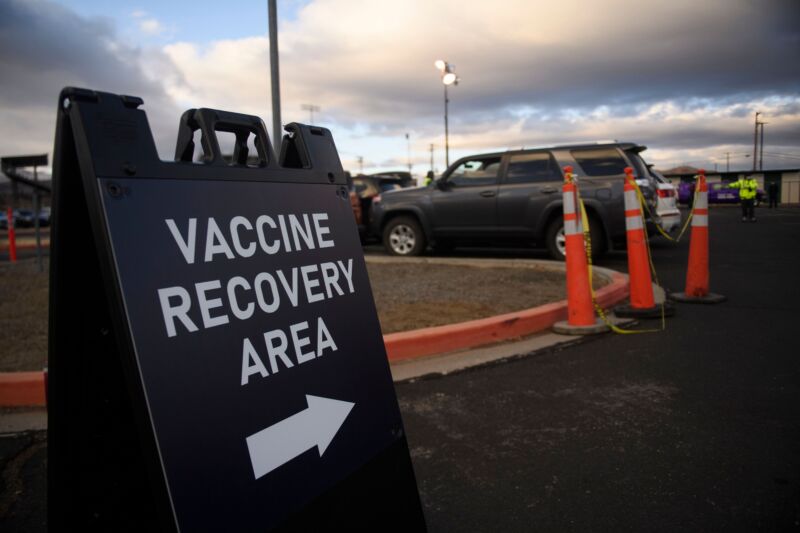
/ A drive-up COVID-19 vaccination site from Renown Health on December 17, 2020, in Reno, Nevada.
Even before their rollout, a distinct feature of safe and effective COVID-19 vaccines has been their “reactogenicity“—that is, their tendency to cause mild symptoms that signal immune responses firing up after a shot, particularly the second one. As vaccine supplies were unleashed in the US last year, families, friends, and coworkers swapped stories of their harrowing post-jab days, often recalling fevers, chills, fatigue, and general crumminess.
Although those experiences are unquestionably real, their connection to the vaccines may not be. As more and more results from randomized-controlled vaccine trials hit science journals, researchers kept noting that, while trial participants often reported mild symptoms after shots, so too did the participants who received placebos—and not at trivial levels.
Many people are familiar with “placebo effects,” which happen when an inert intervention leads people to report health benefits that couldn’t possibly have been caused by the faux treatment. Placebo effects are well-documented and real—in that people can indeed experience a certain extent of psychosomatic benefits. A placebo will not treat serious medical conditions, such as cancer, but it could, for example, lead people to feel they have more energy or less general discomfort.
But placebos also have a dark side. The harmless interventions can just as easily lead people to report harmful side effects, particularly when people are expecting such side effects. Researchers have coined these phantom adverse reactions “nocebo responses.” Nocebo responses are thought to stem from expectations of side effects, anxiety-induced effects, and the mistaken attribution of common, nonspecific ailments, like headaches, to the placebo.
COVID vaccine nocebos
Nocebo responses were startlingly common in trials of COVID-19 vaccines, and a new study quantified just how big a role they played. The meta-analysis, led by Harvard researchers and published Tuesday in JAMA Network Open, looked at side-effect data from 12 high-quality randomized clinical trials testing various COVID-19 vaccines against inert placebo control groups. The analysis concluded that nocebo responses accounted for 76 percent of systemic adverse reactions—like headache, fever, and chills—after the first vaccine dose and 52 percent of systemic reactions after the second vaccine dose.
The rates of side effects in the placebo groups were “substantial,” the researchers, led by Harvard research scientist Julia Haas, concluded. While common, nonspecific symptoms, like fatigue and headache, are among the most common side effects linked to the vaccines, the study found them “to be particularly associated with nocebo.”
Of course, the point of this analysis isn’t just to make you question your sanity (although, seriously, your mind might be messing with you). The main point is that these nocebo responses are likely making safe, life-saving vaccines seem significantly less pleasant than they actually are—and apprehension about such unpleasant side effects is a known reason why some people choose not to get vaccinated.
“Informing the public about the potential for nocebo responses may help reduce worries about COVID-19 vaccination, which might decrease vaccination hesitancy,” Haas and her colleagues wrote. In addition, some clinical evidence suggests that making people aware of nocebo responses can also lower their expectation for side effects and thereby actually lead to fewer perceived side effects.
Real effects
Of course, not all side effects are nocebo responses; some are clearly real, particularly local reactions and side effects after the second dose of a COVID-19 vaccine.
In the meta-analysis, Haas and her colleagues found that about 35 percent of placebo recipients reported at least one systemic side effect after their first faux dose. Meanwhile, 46 percent of vaccine recipients reported at least one systemic side effect after getting their first real dose. When the researchers looked at the severity levels of all of those systemic side effects, they found similar proportions of severity grades between the placebo and vaccine groups. In other words, the vaccine group wasn’t collectively reporting more severe side effects than the placebo group. But there was a clear difference in the local side effects. Only 16 percent of placebo recipients reported local side effects, like pain or swelling at the injection site, while 67 percent of the vaccine group reported such effects.
After the second dose, there were even more differences. About 32 percent of the placebo group reported at least one systemic effect, while 61 percent of the vaccine group reported systemic effects. And in this case, the vaccine group tended to report more moderate to severe systemic effects than the placebo group. As in the first shot, the vaccine group had more local side effects, with about 73 percent reporting local effects while only about 12 percent of people in the placebo group reported them.
Overall, the nocebo responses clearly seem to be skewing our experience with COVID-19 vaccines, which are being used the world over. As such, the researchers argue that highlighting the potential for nocebo responses could reduce side effects and help improve vaccine uptake.